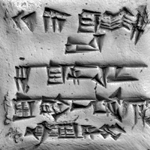|
|
|
History of Graphic Design Typography and Printing Pre-history to 19th Century
|
|
The Caves of Lascaux, France - 15000-10000 BC/Paleolithic



 > > Go to the official site The Cradle of Civilization - 3500-300 BC



 The Code of Hammurabi
The Code of Hammurabi


 Hammurabi created his code of laws, which consists of 282 laws, in the year 1750 BC. The Code of Hammurabi was inscribed on stone, which suggests that the King accepted the laws from the sun god, Shamash. The code of laws encouraged people to accept authority of a king, who was trying to give common rules to govern the subjects' behavior. A complete translation of the Code of Hammurabi can be found here. > > Click here for the Mesopotamian Timeline Egyptian Hieroglyps - 3100 BC-394 AD

 

 The name Rosetta refers to the crucial breakthrough in the research regarding Egyptian hieroglyphs. It especially represents the "translation" of "silent" symbols into a living language, which is necessary in order to make the whole content of information of these symbols accessible. The name Rosetta is attached to the stone of Rosette. This is a compact basalt slab (114x72x28 cm) that was found in July 1799 in the small Egyptian village Rosette (Raschid), which is located in the western delta of the Nile. Today the stone is kept at the British Museum in London. It contains three inscriptions that represent a single text in three different variants of script, a decree of the priests of Memphis in honour of Ptolemaios V. (196 b.c.). The text appears in form of hieroglyphs (script of the official and religious texts), of Demotic (everyday Egyptian script), and in Greek. The representation of a single text of the three mentioned script variants enabled the French scholar Jean Francois Champollion (1790-1832) in 1822 to basically decipher the hieroglyphs. Furthermore, with the aid of the Coptic language (language of the Christian descendants of the ancient Egyptians), he succeeded to realize the phonetic value of the hieroglyphs. This proved the fact that hieroglyphs do not have only symbolic meaning, but that they also served as a "spoken language". Source: http://www.ba.dlr.de/ne/pe/virtis/stone1.htm Fun Corner ::. Write Like an Egyptian The Asian Contribution Origins in China Source: http://www.printersmark.com/Pages/Hist1.html
By the end of the 2nd century AD, the Chinese seem to have discovered printing. They already had available the three elements necessary for printing: (1) paper, (2) ink, and (3) surfaces carved in relief bearing texts.
The Wood Block
At first, the text was written in ink on a sheet of fine paper; then the written side of the sheet was applied to the smooth surface of a block of wood, coated with a rice paste that retained the ink of the text; third, an engraver cut away the uninked areas so that the text stood out in relief and in reverse. To make a print, the wood block was then inked with a paintbrush. A sheet of paper was spread onto the inked surface, and the back of the sheet rubbed with a brush. Only one side of the sheet could be printed in this manner.
The oldest known printed works made by this wood block technique are from Japan (about 764-770) of Buddhist incantations ordered by Empress Shotoku and from China in 868 The first known book, the Diamond Sutra beginning in 932, a collection of Chinese classics in 130 volumes, was made at the initiative of Fong Tao, a Chinese minister.
Invention of movable type (11th century)
Around 1041-48 a Chinese alchemist named Pi Sheng appears to have conceived of movable type made of an amalgam of clay and glue hardened by baking. He composed texts by placing the types side by side on an iron plate coated with a mixture of resin, wax, and paper ash. Gently heating this plate and then letting the plate cool solidified the type. Once the impression had been made, the type could be detached by reheating the plate.
It would thus appear that Pi Sheng had found an overall solution to the many problems of typography: the manufacture, the assembling, and the recovery of reusable type.
Paper Source: http://www2.sjsu.edu/depts/Museum/tsailun.html
This scroll was found in 1907 by the archaeologist Sir Marc Aurel Stein in a walled-up cave at the 'Caves of the Thousand Buddhas', near Dunhuang, in North-West China. It was one of a small number of printed items among many thousands of manuscripts, comprising a library which must have been sealed up in about AD 1000.
Although not the earliest example of blockprinting, it is the earliest which bears an actual date. The colophon, at the inner end, reads: `Reverently [caused to be] made for universal free distribution by Wang Jie on behalf of his two parents on the 13th of the 4th moon of the 9th year of Xiantong [i.e. 11th May, AD 868]'.
|
|
|
|
Home ||
Invention of
Writing ||
The Alphabet
|
|
. : : ART 153 Project HFCC : : . |
|